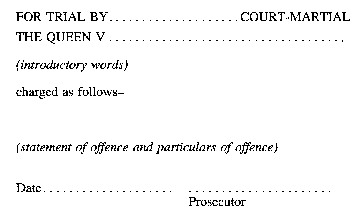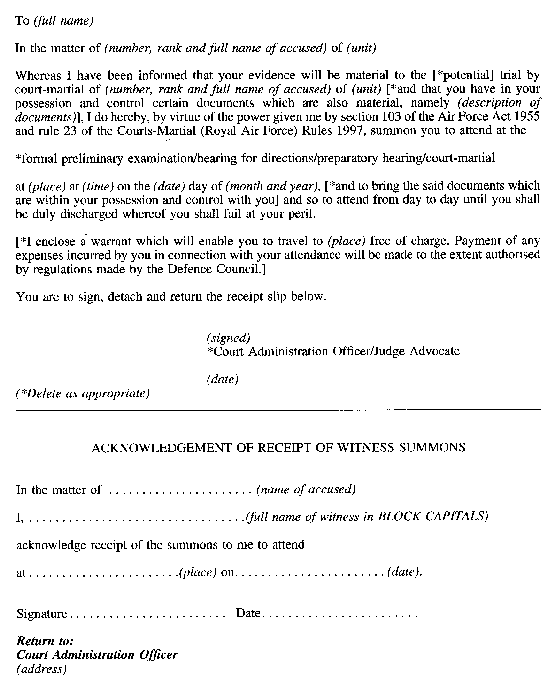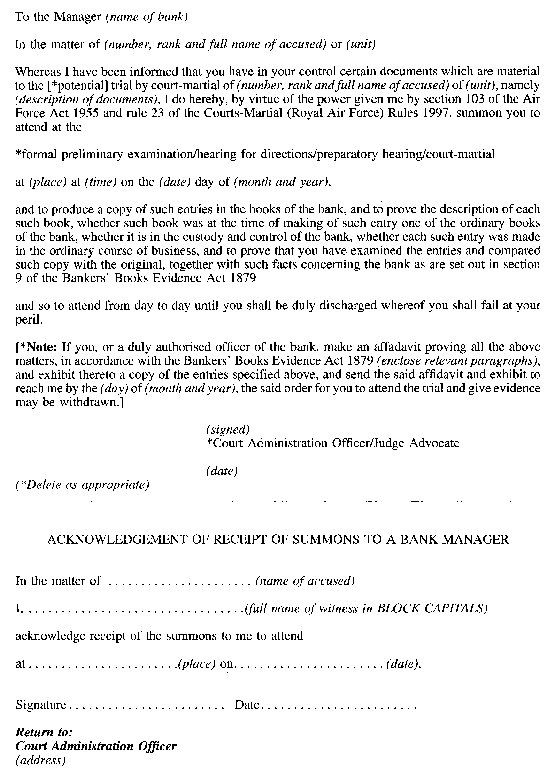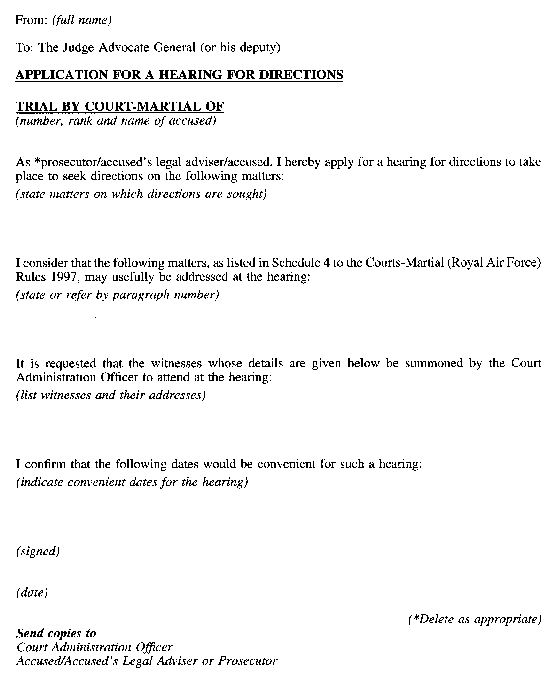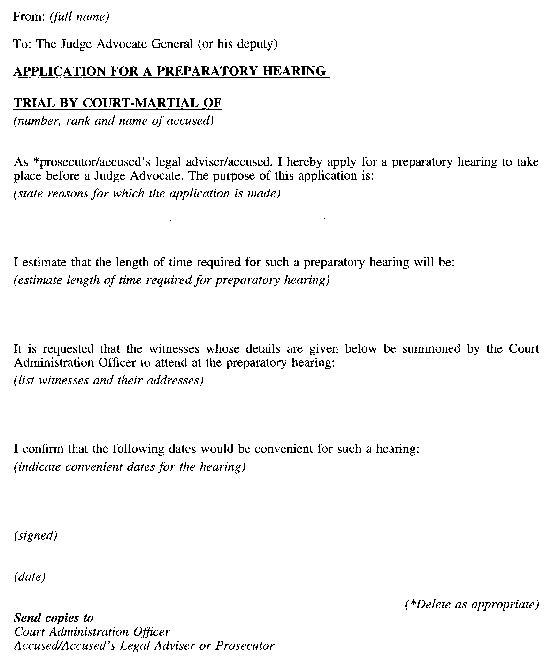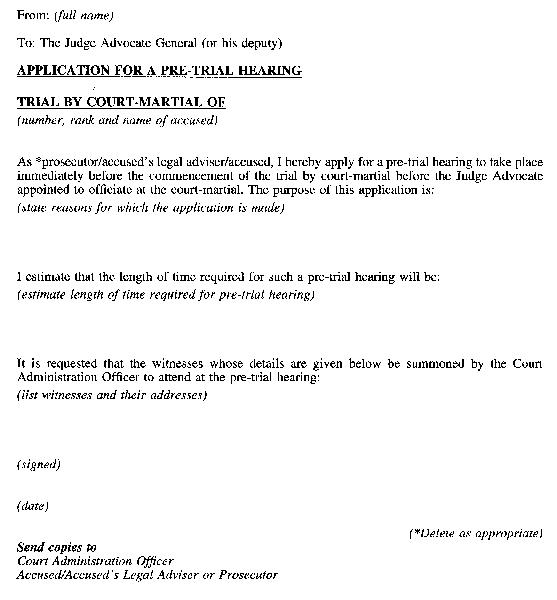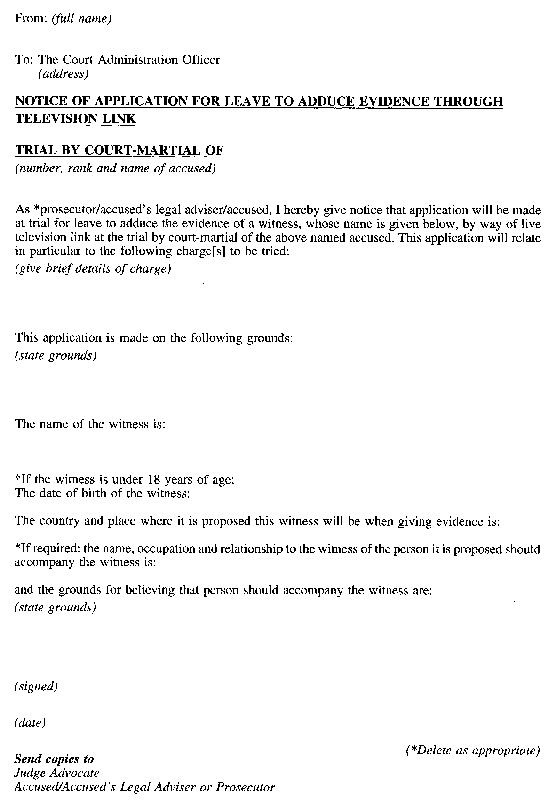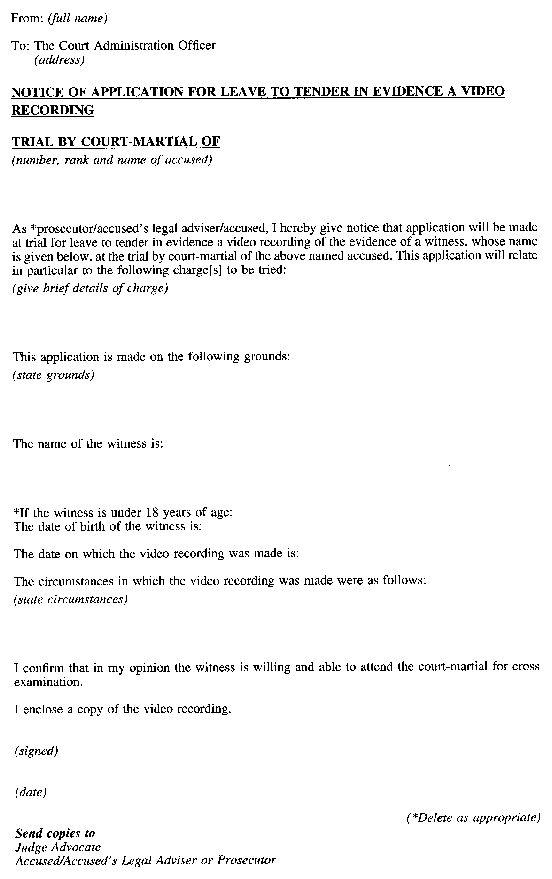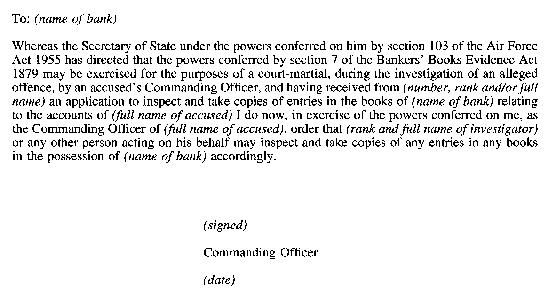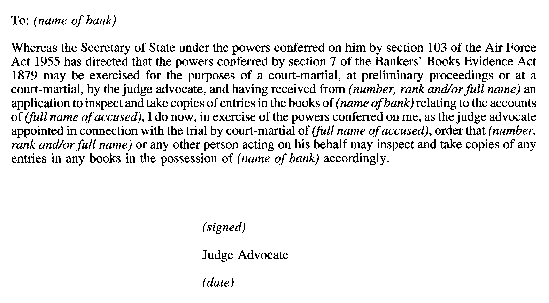- Latest available (Revised)
- Original (As made)
The Courts-Martial (Royal Air Force) Rules 1997
You are here:
- UK Statutory Instruments
- 1997 No. 171
- Schedules only
More Resources
Status:
This is the original version (as it was originally made). This item of legislation is currently only available in its original format.
Rule 8
SCHEDULE 1CHARGES AND JOINDER
PART IRULES
1.—(1) A charge sheet shall be in the form specified in Part II of this Schedule or in a form substantially to the like effect.
(2) Where more than one offence is charged in a charge sheet, the statement and particulars of each offence shall be set out in a separate paragraph called a charge, and paragraphs 2 and 3 of this Part shall apply to each charge in the charge sheet as they apply to a charge sheet where one offence is charged.
(3) The charges shall be numbered consecutively.
2.—(1) Subject only to the provisions of paragraph 3 of this Part, every charge sheet shall contain, and shall be sufficient if it contains, a statement of the specific offence with which the accused person is charged describing the offence shortly, together with such particulars as may be necessary for giving reasonable informtion as to the nature of the charge.
(2) A charge sheet for a specific offence shall not be open to objection in respect of its form if it is framed in accordance with this Schedule.
3. Where the specific offence with which an accused person is charged in a charge sheet is one created by or under an enactment, then (without prejudice to the generality of paragraph 2 of this Part)—
(a)the statement of offence shall contain a reference to—
(i)the section of, or the paragraph of the Schedule to, the Act creating the offence in the case of an offence created by a provision of an Act;
(ii)the provision creating the offence in the case of an offence created by a provision of a subordinate instrument;
(b)the particulars shall disclose the essential elements of the offence:
Provided that an essential element need not be disclosed if the accused person is not prejudiced or embarrassed in his defence by the failure to disclose it;
(c)it shall not be necessary to specify or negative an exception, exemption, proviso, excuse or qualification.
4. Where an offence created by or under an enactment states the offence to be the doing or the omission to do any one of any different acts in the alternative, or the doing or the omission to do any act in any one of any different capacities, or with any one of any different intentions, or states any part of the offence in the alternative, the acts, omissions, capacities or intentions, or other matters stated in the alternative in the enactment or subordinate instrument may be stated in the alternative in a charge sheet charging the offence.
5. It shall be sufficient in a charge sheet to describe a person whose name is not known as a person unknown.
6.—(1) Subject to sub-paragraphs (2) and (3) below, charges for any offences may be joined in the same charge sheet if those charges are founded on the same facts, or form or are a part of a series of offences of the same or a similar character.
(2) An offence under section 37(1)(1) (desertion), section 38(2) (absence without leave) or section 56 (escape from confinement) of the Act may be included in any charge sheet.
(3) An offence under section 46(1)(3) (offences relating to issues and decorations) of the Act may be included in any charge sheet where it arises in connection with a charge under section 37(1) or 38 of the Act.
7. Where the offence charged is one which can be committed in circumstances involving either a higher or a lower degree of punishment, the charge shall state the facts which it is intended to prove as rendering the accused liable to the higher degree of punishment if convicted.
8. Where the offence charged is one which may render the accused liable to the punishment of stoppages, the charge shall state any additional facts which it is intended to prove as rendering the accused liable to that punishment if convicted.
PART II
Rules 23, 25, 29, 37, 60, 61 and 86
SCHEDULE 2FORMS
Where any rule requires the use of a form set out in this Schedule, that requirement shall be satisfied by the use of a form substantially to the like effect as the form set out below.
Form 1—Form of summons to witness
Form 2—Form of summons to a bank manager
Form 3—Form of application for a hearing for directions
Form 4—Form of application for a preparatory hearing
Form 5—Form of application for a pre-trial hearing
Form 6—Form of notice of application for leave to adduce evidence through television link
Form 7—Form of notice of application for leave to tender in evidence a video recording
Form 8—Form of order by commanding officer to permit inspection of bankers' books
Form 9—Form of order by judge advocate to permit inspection of bankers' books
Form 6FORM OF NOTICE OF APPLICATION FOR LEAVE TO ADDUCE EVIDENCE THROUGH TELEVISION LINK made under s.32 of the Criminal Justice Act 1988
Form 7FORM OF NOTICE OF APPLICATION FOR LEAVE TO TENDER IN EVIDENCE A VIDEO RECORDING made under s.32A of the Criminal Justice Act 1988
Rule 24
SCHEDULE 3OATHS AND AFFIRMATIONS
PART IMANNER OF ADMINISTERING OATHS AND AFFIRMATIONS
1. An oath may be administered by the person swearing the oath holding the New Testament, or if a Jew the Old Testament, in his uplifted hand and saying, or repeating after the person administering it, the oath provided in this Schedule for that category of person.
2. A Scottish oath may be administered by the person swearing the oath with uplifted hand and saying, or repeating after the person administering it, the Scottish oath provided in this Schedule for that category of person.
3. An oath may be administered in such manner as the person taking the oath declares to be binding on his conscience in accordance with his religious beliefs where the oath provided in this Schedule for that category of person is modified in accordance with those religious beliefs.
4. A person under 18 making a promise or a person making a solemn affirmation instead of taking an oath shall say or repeat after the person administering the promise of affirmation provided in this Schedule for that category of person.
PART IIFORMS OF OATH
President and members other than the judge advocate
5. I swear by Almighty God that I will well and truly try the accused before the court according to the evidence, and that I will duly administer justice according to law without partiality, favour or affection; and I do further swear that I will not on any account, at any time whatsoever, disclose the vote or opinion of any member of this court-martial, unless thereunto required in due course of law.
Persons under instruction
6. I swear by Almighty God that I will not on any account, at any time whatsoever, disclose the vote or opinion of any member of this court-martial unless thereunto required in due course of law.
Interpreter
7. I swear by Almighty God that I will well and faithfully interpret and make true explanation of all such matters and things as shall be required of me according to the best of my skill and understanding.
Witness
8. I swear by Almighty God that the evidence which I shall give shall be the truth, the whole truth, and nothing but the truth.
Form for a person under 18
9. I promise before Almighty God that the evidence which I shall give shall be the truth, the whole truth, and nothing but the truth.
PART IIIFORM OF SCOTTISH OATHS
10. The form of Scottish oath shall in each case be the same as the form of oath set out above except that for the words“I swear by Almighty God” there shall be substituted the words“I swear by Almighty God and as I shall answer to God at the Great Day of Judgement”.
PART IVFORM OF SOLEMN AFFIRMATIONS
11. The form of affirmation shall in each case be the same as the form of oath set out above except that for the words“I swear by Almighty God” there shall be substituted the words“I solemnly, sincerely, and truly declare and affirm”.
Rule 25
SCHEDULE 4HEARING FOR DIRECTIONS
The matters which may be addressed at a hearing for directions shall include—
1. the issues in the case;
2. issues, if any, as to the mental or medical condition of any defendant or witness;
3. the number of witnesses whose evidence will be placed before the court either orally or in writing;
4. the defence witnesses in 3 above whose statements have been served and whose evidence the prosecution will agree and accept in writing;
5. any prosecution witnesses whom the defence require to attend at the trial;
6. any additional witnesses who may be called by the prosecution and the evidence that they are expected to give;
7. facts which are to be admitted and which can be reduced into writing in accordance with section 10(2)(b) Criminal Justice Act 1967(4), within such time as may be directed at the hearing, and of any witness whose attendance will not be required at the trial;
8. any exhibits and schedules which are to be admitted;
9. the order and pagination of the papers to be used by the prosecution at the trial and the order in which the prosecution witnesses are likely to be called;
10. any alibi which should already have been disclosed in accordance with section 11Criminal Justice Act 1967;
11. any point of law which it is anticipated will arise at trial;
12. any question as to the admissibility of evidence which appears on the face of the papers,and any authority on which the party intends to rely;
13. any application to be made for evidence to be given through live television link;
14. any application to submit pre-recorded video interviews with a child witness as evidence in chief;
15. any application for screens, for use by witnesses seeking a visual break between themselves and any relevant parties;
16. whether any video, tape recorder or other technical equipment will be required during a trial;
17. where a tape recorded interview has taken place, of any dispute or agreement as to the accuracy of any transcript or summary;
18. any other significant matter which might affect the proper and convenient trial of the case, and whether any additional work needs to be done by the parties;
19. the estimated length of the trial, to be agreed more precisely taking account of any views expressed by the judge advocate and the other parties;
20. witness availability and the approximate length of witness evidence;
21. availability of advocate;
22. whether there is a need for any further directions.
Rule 82
SCHEDULE 5GUIDANCE FOR PETITIONERS
1. The petition should be settled with sufficient particularity to enable the reviewing authority to identify clearly the matters relied upon, and set out in such manner as to be reasonably easily understood.
2. The petition should not contain grounds of appeal unless it is considered that such grounds are properly arguable.
3. The petition should not contain any factual inaccuracy.
4. Any allegation of fact in the petition should be based on evidence identified in the petition.
5. The petition should not contain a suggestion that a person (other than the accused) is guilty of impropriety, crime, fraud or misconduct unless such an allegation goes to a matter in issue which is material to the accused’s case and is supported by evidence identified in the petition.
6. Any proposition of law should be supported by references to any relevant authority, and all such authorities must be cited in the petition with sufficient particularity to identify them.
Rule 84
SCHEDULE 6CIVILIANS
PART IMODIFICATIONS FOR CIVILIANS
| Rule | Modification |
|---|---|
| 2 | For the definition of“commanding officer” the substitution of—
The addition, in the appropriate places, of the following definitions—
|
| 4(1) | The omission of sub-paragraph (g). |
| 7(1) | In sub-paragraph (a), the omission of the words“service number and rank”. The omission of sub-paragraph (b). |
| 15 | For paragraph (2) the substitution of— “(2) If the accused so requests, the commanding officer of the accused may appoint a defending officer to assist the accused to prepare and conduct his defence.”. |
| 76(2) | In sub-paragraph (a), the omission of the words“and rank”. The omission of sub-paragraphs (b) and (g). For sub-paragraph (h) the substitution of— “(h)details of the employment of the accused.”. |
PART IIADDITIONAL RULES FOR CIVILIANS
Prosecution of civilians
1.—(1) This rule applies where an accused has elected court-martial trial under article 16 of the Standing Civilian Courts Order 1997(5), or is to be treated under article 17 of that Order as if he had elected court–martial trial.
(2) On receipt of notice of the election, the prosecutor shall determine whether the charge is to be tried by general court-martial or district court-martial.
(3) Subject to paragraph (4) below, an accused shall be treated for the purposes of these Rules as if had been notified by his commanding officer that he is to be tried by court-martial under rule 11 above.
(4) The prosecutor shall serve on the accused and the court administration officer a charge sheet appropriate for the court-martial trial.
Accused’s parent or guardian
2.—(1) This rule applies where—
(a)an accused is under the age of 17 years, or
(b)the offence with which the accused is charged is alleged to have been committed during a period of parental recognisance.
(2) Where the prosecutor or the court administration officer is required to serve any document on the accused under these Rules, he shall as soon as is practicable serve a copy of that document on a parent or guardian of the accused who is a service parent or guardian.
(3) Where the accused has not appointed a legal adviser, any parent or guardian of the accused may exercise on behalf of the accused the rights granted to the accused in rule 6(2)above and may represent the accused during the court-martial and any preliminary proceedings in such manner and to such extent as the judge advocate thinks fit.
(4) The court administration officer shall issue a witness summons in accordance with rule23 above in respect of any parent or guardian on whom a document has been served in accordance with paragraph (2) above to attend the court-martial.
(5) Any parent or guardian of the accused may, if present—
(a)give evidence on oath and call witnesses; and
(b)address the court.
PART IIIAPPEALS FROM STANDING CIVILIAN COURTS
Forwarding an appeal to the prosecuting authority
3.—(1) When the higher authority receives a notice of appeal against conviction or sentence (or both) lodged under paragraph 18(3) of Schedule 3 to the Armed Forces Act 1976(6), he shall forward the notice to the prosecuting authority with a view to the appeal being heard by a court-martial.
(2) On receipt of a notice under paragraph (1) above, the prosecutor shall determine whether the appeal is to be heard by general court-martial or district court-martial.
(3) Subject to rules 4 to 6 below, these Rules shall be complied with as if the charge which is the subject of the appeal were a charge preferred against the accused under section 83B(4)(7) of the Act.
Charge sheet on appeal
4.—(1) Any alternative charge preferred against the accused for trial by the Standing Civilian Court on which no finding was made may be added to the charge sheet for trial by the court–martial.
(2) The prosecutor may not amend or substitute another charge or charges for, or discontinue proceedings on, the charge which is the subject of the appeal.
Appeal against sentence alone
5. Where the appeal in respect of a charge is against sentence alone, the court shall proceed after the commencement of the court-martial trial as if the accused had pleaded guilty to that charge.
Sentencing on appeal
6.—(1) Where the appeal in respect of a charge is against conviction alone and the court find the accused guilty of the charge, it shall pass as the sentence of the court-martial in respect of that charge the sentence passed for that offence by the Standing Civilian Court or any lesser sentence which it considers appropriate.
(2) In any other case where, on appeal, the court-martial is required to pass sentence, it shall proceed to sentence the accused in accordance with these Rules subject to paragraphs(3) to (5) below.
(3) The prosecutor shall, where practicable, in addition to the information listed in rule 76(2) above as modified by Part I of this Schedule, present to the court information concerning—
(a)any offences which the Standing Civilian Court took into consideration;
(b)the result of any review of the findings or sentence of the Standing Civilian Court.
(4) In addition to its power under rule 74 above, the court may take into consideration any offence which was taken into consideration by the Standing Civilian Court and as to the judge advocate seems proper.
(5) The court shall award a separate sentence for each offence.
Appeal by parent or guardian of an accused
7. Where a parent or guardian appeals against an order against him made by the Standing Civilian Court under paragraph 13 of Schedule 5A to the Act, and the accused in respect of whose conviction the order was made does not appeal against that conviction, the court administration officer shall issue a witness summons in respect of that accused to attend the court-martial.
Abandonment of appeal
8.—(1) An accused who has given notice of appeal to a court-martial against finding or sentence of a Standing Civilian Court may abandon the appeal or any part of it at any time before the commencement of the trial by court-martial by giving notice in writing to the court administration officer.
(2) An accused who has given notice of appeal to a court-martial may not abandon the appeal or any part of it after the commencement of the trial by court-martial except with the leave of the court-martial.
(3) Where an accused fails to appear before the court-martial at the appointed time or subsequently thereafter, the judge advocate, if he considers that there is no reasonable explanation for the failure to appear, may direct that the appeal be treated as abandoned.
(4) An accused may not revive an appeal or any part of it which he has abandoned or which is treated as abandoned.
Rule 90
SCHEDULE 7REVOCATIONS
| Rules revoked | Reference |
|---|---|
| The Rules of Procedure (Air Force) 1972 | S.I. 1972/419 |
| The Rules of Procedure (Air Force) (Amendment) Rules 1974 | S.I. 1974/752 |
| The Rules of Procedure (Air Force) (Amendment) Rules 1976 | S.I. 1976/1772 |
| The Rules of Procedure (Air Force) (Amendment) Rules 1977 | S.I. 1977/94 |
| The Rules of Procedure (Air Force) (Amendment) Rules 1981 | S.I. 1981/1219 |
| The Rules of Procedure (Air Force) (Amendment) Rules 1982 | S.I. 1982/368 |
| The Rules of Procedure (Air Force) (Amendment) Rules 1983 | S.I. 1983/718 |
| The Rules of Procedure (Air Force) (Amendment) Rules 1986 | S.I. 1986/2125 |
| The Rules of Procedure (Air Force) (Amendment) Rules 1987 | S.I. 1987/2000 |
| The Rules of Procedure (Air Force) (Amendment No. 2) Rules 1987 | S.I. 1987/2172 |
| The Rules of Procedure (Air Force) (Amendment) Rules 1989 | S.I. 1989/2129 |
| The Rules of Procedure (Air Force) (Amendment) Rules 1991 | S.I. 1991/2786 |
| The Rules of Procedure (Air Force) (Amendment) Rules 1996 | S.I. 1996/1389 |
| The Rules of Procedure (Air Force) (Amendment No. 2) Rules 1997 | S.I. 1997/14 |
Section 37(1) was substituted by the Armed Forces Act 1971 (c. 33), section 11.
Section 38 was substituted by the Armed Forces Act 1971, section 12.
Section 46 was substituted by the Armed Forces Act 1971, section 17.
Sections 9, 10 and 11 of the Criminal Justice Act 1967 are applied to proceedings before courts-martial subject to the modifications prescribed by the Criminal Justice Act 1967 (Application to Courts-Martial) (Evidence) Regulations 1997 (S.I. 1997/173).
S.I. 1997/172.
1976 c. 52; Schedule 3 was amended by the Armed Forces Act 1996, section 5 and Schedule 1.
Section 83B was inserted by the Armed Forces Act 1996, section 5 and Schedule 1.
Options/Help
Print Options
PrintThe Whole Instrument
PrintThe Schedules only
Legislation is available in different versions:
Latest Available (revised):The latest available updated version of the legislation incorporating changes made by subsequent legislation and applied by our editorial team. Changes we have not yet applied to the text, can be found in the ‘Changes to Legislation’ area.
Original (As Enacted or Made): The original version of the legislation as it stood when it was enacted or made. No changes have been applied to the text.
More Resources
Access essential accompanying documents and information for this legislation item from this tab. Dependent on the legislation item being viewed this may include:
- the original print PDF of the as enacted version that was used for the print copy
- lists of changes made by and/or affecting this legislation item
- confers power and blanket amendment details
- all formats of all associated documents
- correction slips
- links to related legislation and further information resources
